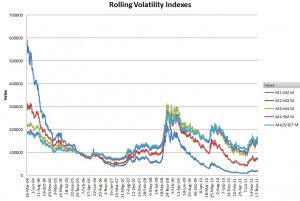If your interests are related to the simulation / backtest of volatility exchange-traded products like VXX and XIV, then you should review the products I have listed here. While the indexes discussed in this post can be used to compute the prices of the volatility ETPs it is not an entirely straightforward process.
I have generated both the Excess Return (ER) and Total Returns (TR) trading day values for the following rolling indexes of VIX volatility futures starting on March 26, 2004 through December 12, 2014.
- Month 1-2 rolling indexes, constant weighted average 1 month (Similar to SPVXSTR and SPVXSP)
- Month 2-3 rolling indexes, constant weighted average 2 months
- Month 3 -4 rolling indexes, constant weighted average 3 months
- Month 4-5 rolling indexes, constant weighted average 4 months
- Month 4-5-6-7 rolling indexes, constant weighted average 5 months (Similar to SPVXMTR and SPVXMP) This is considered the “Midterm” maturity.
These indexes, or ones like them are required if you want to backtest various ETP products or evaluate your own volatility strategy.

These rolling indexes don’t exactly match the official indexes (SPVXSTR, SPVXSP, SPVIX2MT, SPVIX3MT, SPVIX4MT, SPVXMP, and SPVXMTR), but when I compare my results to the values available on Bloomberg my results track within +-0.03% for the values I have sampled from December 2008 to December 2011 for each of the indexes. See this readme file for more information on accuracy comparisons. The official indexes start on December 20th, 2005, but I pushed them back to the beginning of VIX volatility futures trading which was in March 2004 by extrapolating mssing front month data.
In working through the details of the algorithms there were no major surprises, but there were some subtleties—like discovering the market was closed on January 2, 2007 to commemorate President Reagan. One significant detail is that the day-to-day rolling of the futures is done on a dollar-weighted basis. For example on the rolling 1 to 2 month index, if there are a total of 21 trading days in the current first-month futures, it is not 1/21 of the contracts that are rolled over to the second month each day—it’s 1/21th of the dollar value of the index that is rolled over. The reason for this distinction is that the goal of the index is to give a constant duration or maturity (e.g., 2 months), if the roll amount isn’t dollar-weighted then contango/backwardation would shift that duration one way or the other.

Vance,
Thank you for the wonderful work you have done! Your website is among the few I use as I learn about volatility ETPs. I recently started trading short volatility (going long XIV and put VXX option). I wanted to back-test long XIV strategy when VIX:VXV is below a certain ratio. I have been able to download historical VIX data from various sources. However, I haven’t been lucky when it comes to historical data from VXV. Where would I find this data? Thanks!
Vance,
I’m just wondering if the files you are selling include the associated futures data. I know I can get that data and add it to the spreadsheet I buy from you, but if it were already there it would be easier.
The other thing is what price(s) did you use to construct the data: open, close, settle?
Thanks,
Ian
Hi Ian,
If you buy the indexes I’ll email you the associated futures data also. The indexes use the settlement values, so that is what I use to construct the indexes.
— Vance
Hi Vance, I’d like to do some ZIV back testing a bit further back than the time when it listed (Nov’10). That would be index no. 5 right? Just to be sure your time series ends on the 29th Nov 10 with a value for the index near 12.30? (thats what Yahoo gives me as the closing price of ZIV for the 30th Nov 10)
actually I suppose if anything the data will match VXZ rather than ZIV – is there a way for me to convert that to ZIV? Also somewhere on the page I came across that you have VXV data prior to the official start in dec 2007. Do you sell that ws well?
thanks,
Marco.
Hi Marco, You’re right, the Rolling index data will match VXZ with a simple multiplication factor. ZIV requires a slightly more complicated calculation. I sell a ZIV backtest spreadsheet to Mar 2004 for $20–that’s probably the easiest approach. It has a good match to the historic prices. If you are interested send me an email at [email protected]. Regarding VXV data, I will send you the data I have back to 2002 for free, just send an email to [email protected] and I will send that to you.
Best Regards,
Vance
seems to me that the main point that people don’t understand is the detail you mentioned in the last paragraph about how the rolling is done on a dollar-weighted basis
Hi mn,
Thanks!. Yes, the dollar weighting is a tripping point. Those that try to deal just with VIX futures contracts get caught on that one, the percentage change calculation is also tricky, if done incorrectly it can introduce an error term that only shows up when there are big moves.
— Vance
kudos to you for accurately calculating these indices underlying the volatility etns … the amount of inaccurate information on various blogs and websites about products like the vxx is staggering